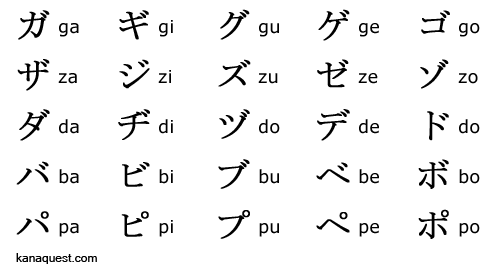Katakana II
In the last lesson on katakana, we read that katakana is a Japanese alphabet that is used for foreign words and names. In this lesson, we'll talk more about katakana, but first, here's the vocabulary for this lesson. Each word is written in katakana in Japanese, and is shown below in romaji, katakana, and English respectively.
|
piano ピアノ piano gita- ギター guitar itaria イタリア italy |
anime アニメ animation aisu kurimu アイスクリム ice cream amerika アメリカ america (usa) |
shatsu シャツ shirt ko-hi- コーヒー coffee arubamu アルバム album |
While many of the non-Asian foreign words used in Japanese come from the English language, there are still many from other European languages. For a list of these words, see this page.
Dakuten and Handakuten
Both katakana and hiragana have two special groups of characters, called dakuten and handakuten. Each character is a slightly altered version of a basic character (one on the chart in this lesson). Dakuten characters have two small dashes on the top-right of a character, similar to a quotation mark. Handakuten characters have a small circle on the top-right of a character, similar to a degree sign. These characters were created to represent g, z, d, b, and p sounds. Below is a chart of dakuten and handakuten characters.

The ー character
In katakana, the character ー (similar to but not the same as the kanji character 一, meaning "one") is used to show that the previous vowel should be spoken longer than usual. So the word ギター ("gita-") is pronounced gitaa, with a long a. In romaji, this can either be shown by adding a dash (-) to replace ー, or by adding the same vowel again, so コーヒー can be written as either "ko-hi-" or "koohii".
Note that ー is only used in katakana, not hiragana.